Instruction
How changing your stance can unlock more distance
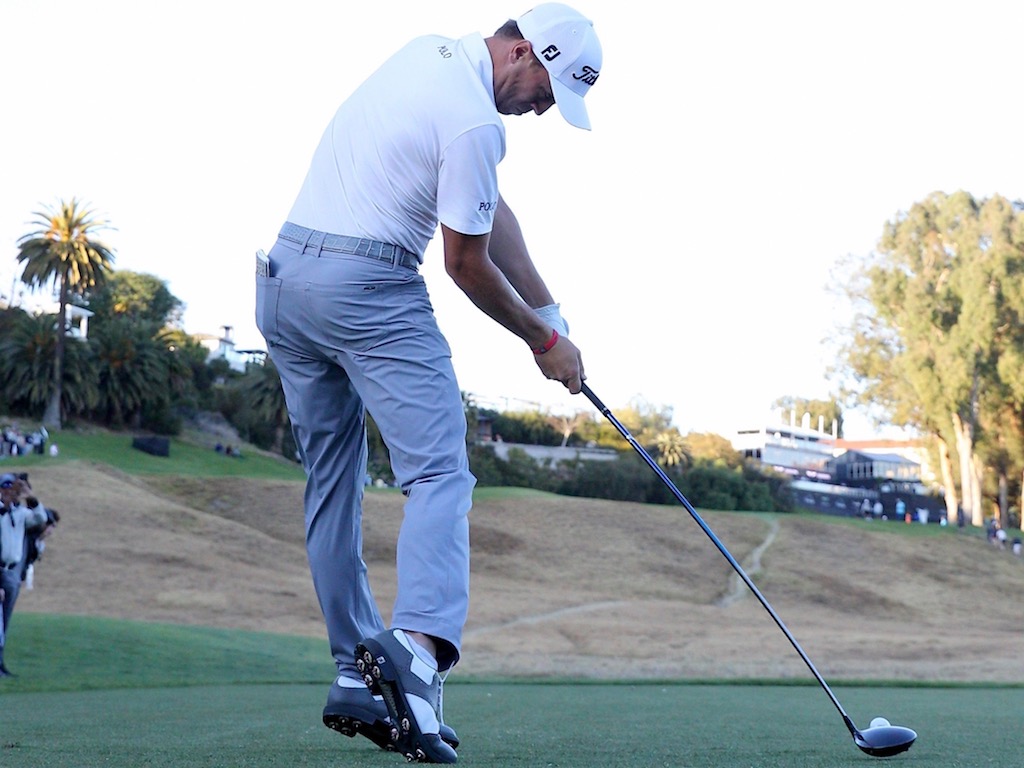
Ground Reaction Forces (GRF) continue to be a hot topic in golf instruction. We know that many of the longest hitters in the game use the ground more dynamically than the regular weekend golfer to create more distance. So can something as simple as how you address the golf ball going to influence how dynamic your GRFs are and how much distance you can create? The simple answer, absolutely, and maybe it is a less disruptive way of trying to unlock more distance.
I think we’ve all had the question of how far away should we be standing away from the golf ball. With measuring devices like BodiTrak and Swing Catalyst, there are some fun patterns for golfers consider and potentially apply to add power to their golf swings. So let’s take a look at some of these findings and discuss how they might help you create more power in your game.
For this article. I identified GRF data about the three different distances that a golfer can stand away from the golf ball:
- Stock stance: This is the instinctive distance golfers use to stand next to the golf ball and successfully hit it.
- Standing farther away from the ball: I have measured all of my students for this research when the golf ball is placed a distance of approximately two golf balls farther away from their body. This posture has them tending to tilt more from their hips and become more toe-oriented in their setup.
- Standing closer to the ball: I have measured all of my students for this research when the golf ball is placed a distance of approximately two balls closer to their body. This posture has them tending to stand a little taller and becoming more heel-oriented for their setup.
What I found was that no matter what their swing style was, most golfers saw a significant bump in their GRFs (how much harder they press off the ground) when they stood either closer to or farther away from the golf ball.
So why does this happen? Let’s start off with standing farther away from the golf ball.
When golfers are farther away from the golf ball, most of them use more hip hinge to be able to reach the golf ball. More hip hinge means that their swing circle (the arc that they swing the golf club upon) just got closer to the ground. Almost every athlete that I measure resolves the problem of being closer to the ground with their swing circle by jumping away from the golf ball and ground, or trying to raise their swing circle so they do not hit the turf before they hit the golf ball. This is an extremely athletic motion that takes place in the downswing that has golfers pressing harder off the ground earlier than normal in their downswing sequence to better ensure they hit the golf ball first.
Let’s look now at the golfers that are standing closer to the golf ball at address. These golfers also tend to press harder off the ground earlier in the downswing sequence. The reason is similar. When golfers stand closer to the golf ball, their swing circle gets closer to the golf ball. When their swing circle is closer than normal to the golf ball, they naturally try to find a dynamic way to get farther away from the golf ball (instinctively, golfers want to ensure ensure that their hosel does not hit a…. well, we won’t grace that evil word in this article)
So let’s take a look at three different golfers and note how differently they respond to the task of hitting a golf ball from different setup positions.
Golfer 1
If you want a deeper look into our first golfer’s Swing DNA, like Center of Pressure, GRF’s and lateral playing characteristics click here. Or if you want the simple version, note that this golfer is right-handed, tall, skinny and wants to hit the golf ball farther.
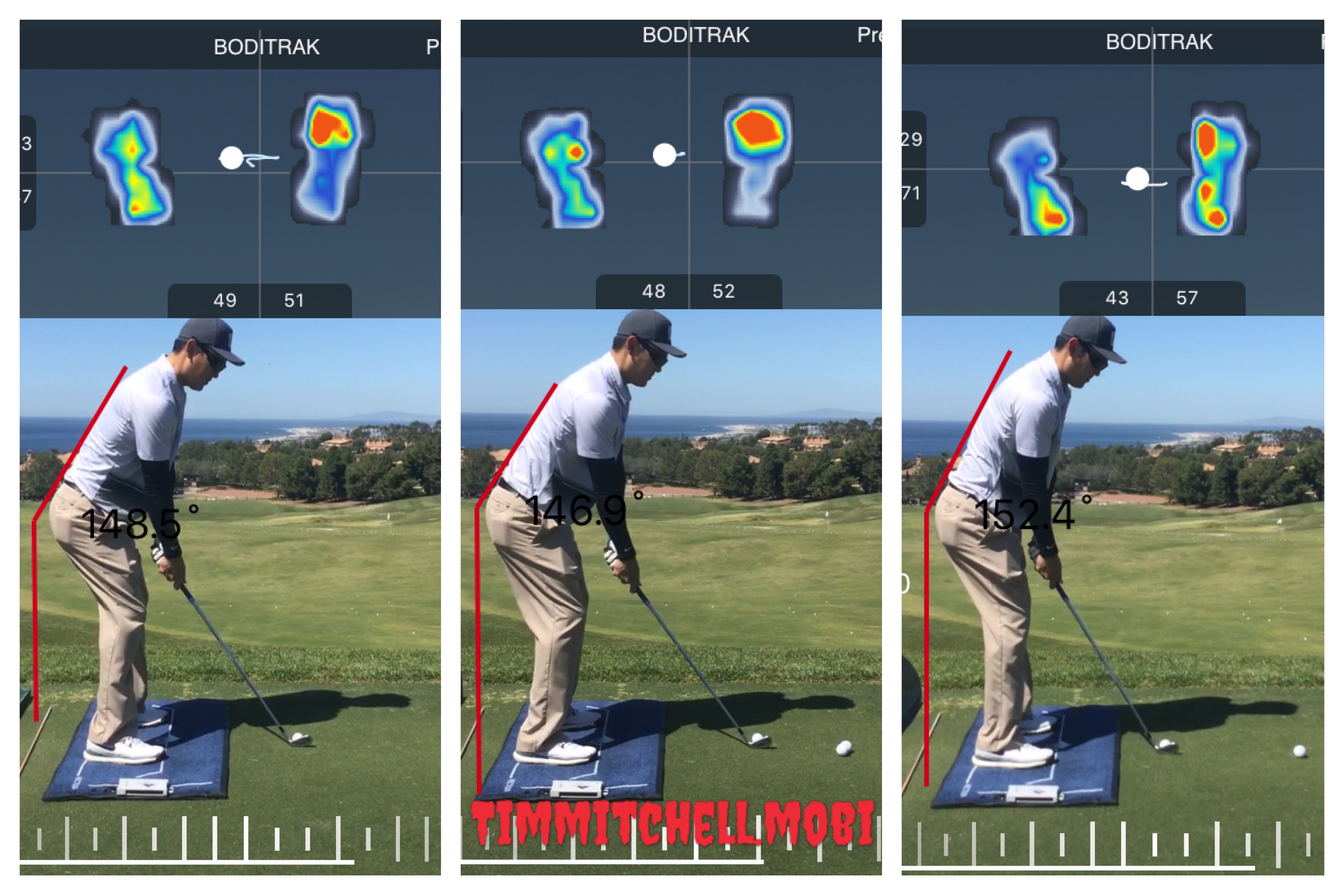
Left photo is Stock Ball Position. Center Photo is 2-Balls Away. Right Photo is 2-Balls Closer. Note how the different ball positions change the amount of hip hinge the player must use to address the ball. Also, note how the player’s feet always start from the same position on the BodiTrak Mat.

We measured this specific position, which is close to where most hitters maximize GRFs. Note how the GRFs for this golfer’s stock ball position is 94 percent of his body weight. That percentage increases to 105 percent with the ball farther away from his body and to 106 percent with the ball closer to his body. That’s an increase of more than 10 percent of this golfer’s body weight.
Golfer 2
If you want a deeper look into our second golfer’s Swing DNA, click here. Or if you want the simplified version, this golfer is left handed and slightly thicker than Player 1. He plays golf for a living on multiple professional tours around the world.
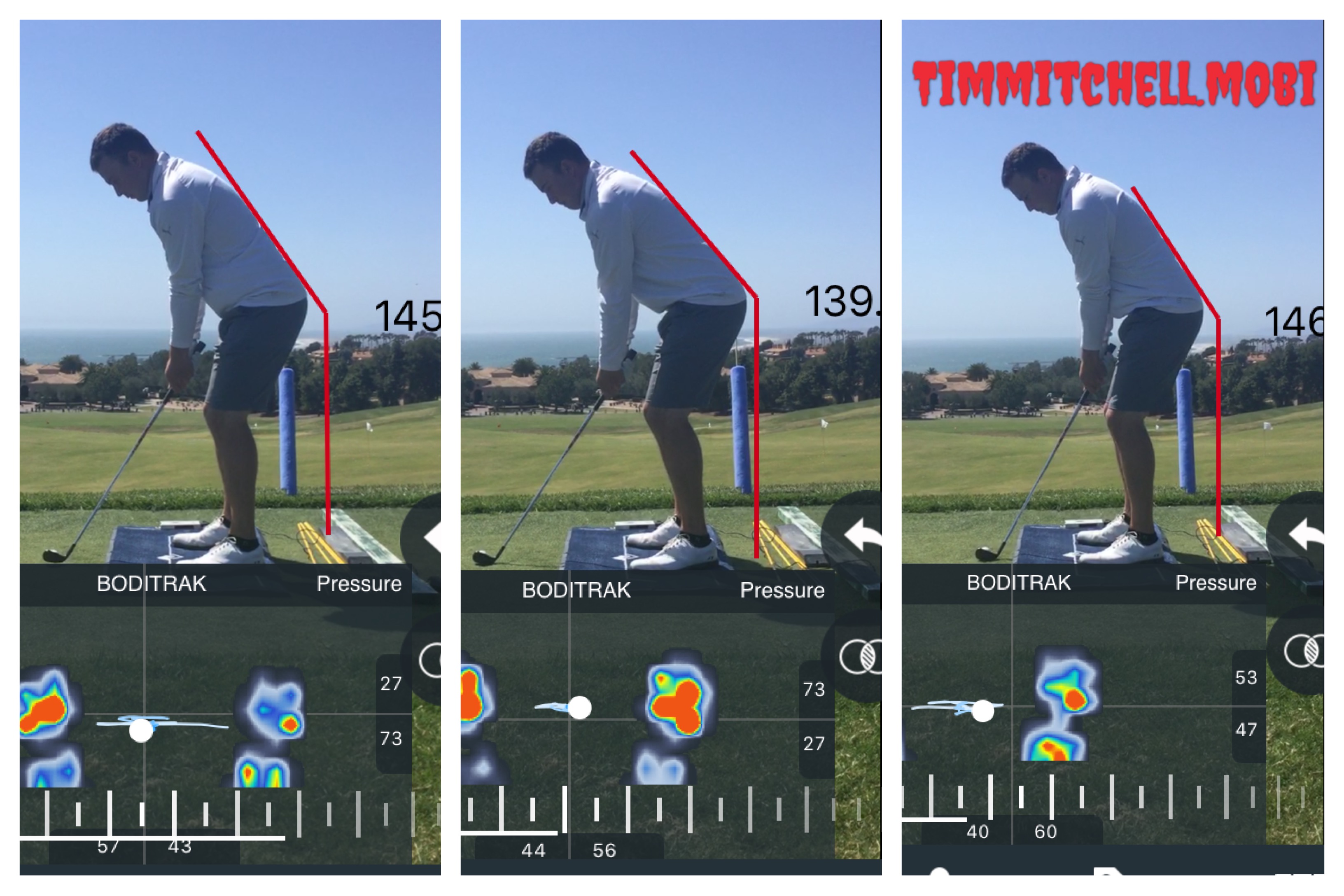
Left photo is Stock Ball Position. Center Photo is 2-Balls Away, and Right Photo is 2-Balls Closer. Note how the different ball positions change the amount of hip hinge the player must use to address the ball. Also, note how the player’s feet always start from the same position on the BodiTrak Mat.
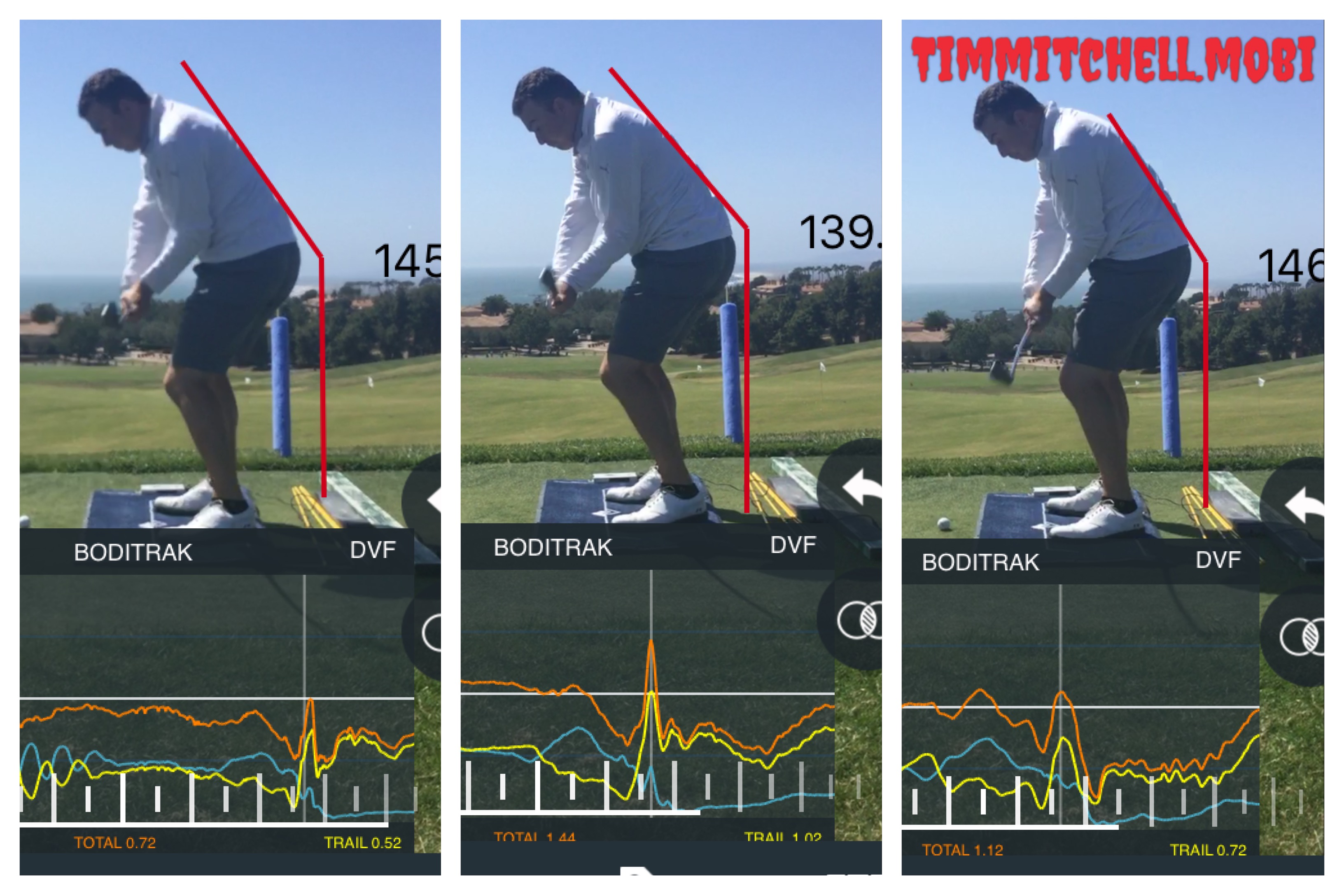
We measured this specific position of our golfer’s motion, which is close to where most hitters maximize GRFs. Note how the GRF’s for this golfer’s stock ball position are 72 percent of his body weight. That percentage increases to 144 percent with the ball farther away and 112 percent with the ball closer to his body. That’s an increase of 72 percent of this golfer’s body weight when the ball is farther away, and an increase of 40 percent when the golf ball is closer to his body.
Golfer 3
If you want a deeper look into our third golfer’s Swing DNA, click here. Or if you want the simplified version, he is right handed, shorter than our first player and models his golf swing after Justin Thomas.

Left photo is Stock Ball Position. Center Photo is 2-Balls Away, and Right Photo is 2-Balls Closer. Note how the different ball positions change the amount of hip hinge the player must use to address the ball. Also, note how the player’s feet always start from the same position on the BodiTrak Mat.
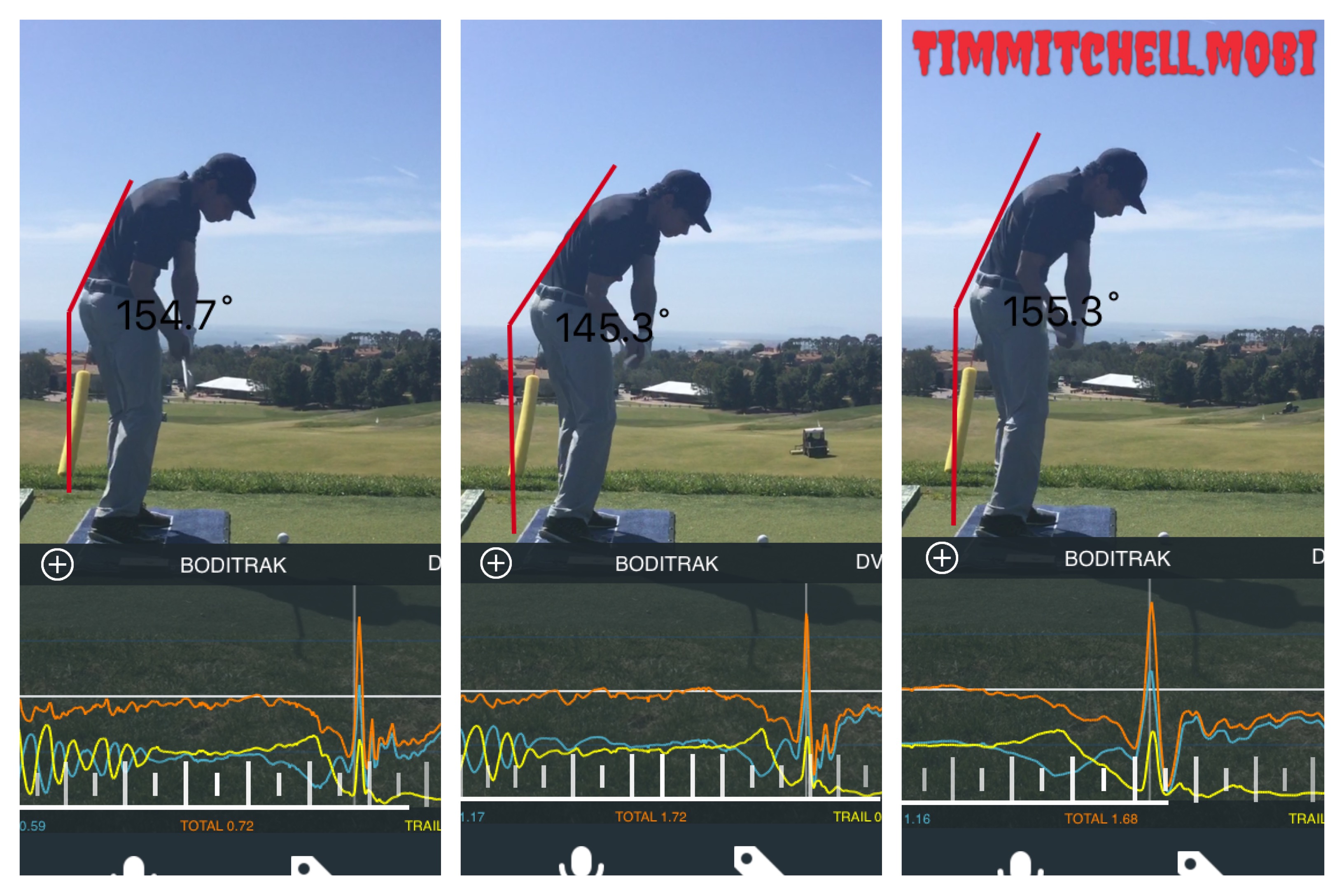
We measured this specific position of our golfer’s motion, which is close to where most hitters maximize GRFs. Note how the GRF’s for this golfer’s stock ball position are 72 percent of his body weight. That percentage increases to 172 percent with the ball farther away and 168 percent with the ball closer to his body. That’s an increase of 100 percent of his body weight when he is farther away from the ball, and 98 percent of his body weight when the golf ball is closer to his body.
So what can we take away from this article?
Three different body types, three different skill levels and three different individuals with very different Swing DNAs increased their GRF’s by simply moving closer to or farther away from the golf ball. Therefore, experimenting with ball position might be a simpler, less disruptive key to help you unlock some undiscovered distance in your game… solely by altering your setup. Experiment with this information or go find your trusted PGA Teaching Professional to help you unlock how your golf swing can improve with this information. Good luck!
- LIKE76
- LEGIT9
- WOW5
- LOL5
- IDHT7
- FLOP5
- OB4
- SHANK111
Instruction
The Wedge Guy: The easiest-to-learn golf basic

My golf learning began with this simple fact – if you don’t have a fundamentally sound hold on the golf club, it is practically impossible for your body to execute a fundamentally sound golf swing. I’m still a big believer that the golf swing is much easier to execute if you begin with the proper hold on the club.
As you might imagine, I come into contact with hundreds of golfers of all skill levels. And it is very rare to see a good player with a bad hold on the golf club. There are some exceptions, for sure, but they are very few and very far between, and they typically have beat so many balls with their poor grip that they’ve found a way to work around it.
The reality of biophysics is that the body moves only in certain ways – and the particulars of the way you hold the golf club can totally prevent a sound swing motion that allows the club to release properly through the impact zone. The wonderful thing is that anyone can learn how to put a fundamentally sound hold on the golf club, and you can practice it anywhere your hands are not otherwise engaged, like watching TV or just sitting and relaxing.
Whether you prefer an overlap, interlock or full-finger (not baseball!) grip on the club, the same fundamentals apply. Here are the major grip faults I see most often, in the order of the frequency:
Mis-aligned hands
By this I mean that the palms of the two hands are not parallel to each other. Too many golfers have a weak left hand and strong right, or vice versa. The easiest way to learn how to hold the club with your palms aligned properly is to grip a plain wooden ruler or yardstick. It forces the hands to align properly and shows you how that feels. If you grip and re-grip a yardstick several times, then grip a club, you’ll see that the learning curve is almost immediate.
The position of the grip in the upper/left hand
I also observe many golfers who have the butt of the grip too far into the heel pad of the upper hand (the left hand for right-handed players). It’s amazing how much easier it is to release the club through the ball if even 1/4-1/2″ of the butt is beyond the left heel pad. Try this yourself to see what I mean. Swing the club freely with just your left hand and notice the difference in its release from when you hold it at the end of the grip, versus gripping down even a half inch.
To help you really understand how this works, go to the range and hit shots with your five-iron gripped down a full inch to make the club the same length as your seven-iron. You will probably see an amazing shot shape difference, and likely not see as much distance loss as you would expect.
Too much lower (right) hand on the club
It seems like almost all golfers of 8-10 handicap or higher have the club too far into the palm of the lower hand, because that feels “good” if you are trying to control the path of the clubhead to the ball. But the golf swing is not an effort to hit at the ball – it is a swing of the club. The proper hold on the club has the grip underneath the pad at the base of the fingers. This will likely feel “weak” to you — like you cannot control the club like that. EXACTLY. You should not be trying to control the club with your lower/master hand.
Gripping too tightly
Nearly all golfers hold the club too tightly, which tenses up the forearms and prevents a proper release of the club through impact. In order for the club to move back and through properly, you must feel that the club is controlled by the last three fingers of the upper hand, and the middle two fingers of the lower hand. If you engage your thumbs and forefingers in “holding” the club, the result will almost always be a grip that is too tight. Try this for yourself. Hold the club in your upper hand only, and squeeze firmly with just the last three fingers, with the forefinger and thumb off the club entirely. You have good control, but your forearms are not tense. Then begin to squeeze down with your thumb and forefinger and observe the tensing of the entire forearm. This is the way we are made, so the key to preventing tenseness in the arms is to hold the club very lightly with the “pinchers” — the thumbs and forefingers.
So, those are what I believe are the four fundamentals of a good grip. Anyone can learn them in their home or office very quickly. There is no easier way to improve your ball striking consistency and add distance than giving more attention to the way you hold the golf club.
More from the Wedge Guy
- The Wedge Guy: Golf mastery begins with your wedge game
- The Wedge Guy: Why golf is 20 times harder than brain surgery
- The Wedge Guy: Musings on the golf ball rollback
- LIKE85
- LEGIT13
- WOW6
- LOL1
- IDHT0
- FLOP4
- OB1
- SHANK8
Instruction
Clement: Stop ripping off your swing with this drill!

Not the dreaded headcover under the armpit drill! As if your body is defective and can’t function by itself! Have you seen how incredible the human machine is with all the incredible feats of agility all kinds of athletes are accomplishing? You think your body is so defective (the good Lord is laughing his head off at you) that it needs a headcover tucked under the armpit so you can swing like T-Rex?
- LIKE0
- LEGIT2
- WOW2
- LOL0
- IDHT0
- FLOP0
- OB0
- SHANK2
Instruction
How a towel can fix your golf swing

This is a classic drill that has been used for decades. However, the world of marketed training aids has grown so much during that time that this simple practice has been virtually forgotten. Because why teach people how to play golf using everyday items when you can create and sell a product that reinforces the same thing? Nevertheless, I am here to give you helpful advice without running to the nearest Edwin Watts or adding something to your Amazon cart.
For the “scoring clubs,” having a solid connection between the arms and body during the swing, especially through impact, is paramount to creating long-lasting consistency. And keeping that connection throughout the swing helps rotate the shoulders more to generate more power to help you hit it farther. So, how does this drill work, and what will your game benefit from it? Well, let’s get into it.
Setup
You can use this for basic chip shots up to complete swings. I use this with every club in my bag, up to a 9 or 8-iron. It’s natural to create incrementally more separation between the arms and body as you progress up the set. So doing this with a high iron or a wood is not recommended.
While you set up to hit a ball, simply tuck the towel underneath both armpits. The length of the towel will determine how tight it will be across your chest but don’t make it so loose that it gets in the way of your vision. After both sides are tucked, make some focused swings, keeping both arms firmly connected to the body during the backswing and follow through. (Note: It’s normal to lose connection on your lead arm during your finishing pose.) When you’re ready, put a ball in the way of those swings and get to work.

Get a Better Shoulder Turn
Many of us struggle to have proper shoulder rotation in our golf swing, especially during long layoffs. Making a swing that is all arms and no shoulders is a surefire way to have less control with wedges and less distance with full swings. Notice how I can get in a similar-looking position in both 60° wedge photos. However, one is weak and uncontrollable, while the other is strong and connected. One allows me to use my larger muscles to create my swing, and one doesn’t. The follow-through is another critical point where having a good connection, as well as solid shoulder rotation, is a must. This drill is great for those who tend to have a “chicken wing” form in their lead arm, which happens when it becomes separated from the body through impact.
In full swings, getting your shoulders to rotate in your golf swing is a great way to reinforce proper weight distribution. If your swing is all arms, it’s much harder to get your weight to naturally shift to the inside part of your trail foot in the backswing. Sure, you could make the mistake of “sliding” to get weight on your back foot, but that doesn’t fix the issue. You must turn into your trial leg to generate power. Additionally, look at the difference in separation between my hands and my head in the 8-iron examples. The green picture has more separation and has my hands lower. This will help me lessen my angle of attack and make it easier to hit the inside part of the golf ball, rather than the over-the-top move that the other picture produces.


Stay Better Connected in the Backswing
When you don’t keep everything in your upper body working as one, getting to a good spot at the top of your swing is very hard to do. It would take impeccable timing along with great hand-eye coordination to hit quality shots with any sort of regularity if the arms are working separately from the body.
Notice in the red pictures of both my 60-degree wedge and 8-iron how high my hands are and the fact you can clearly see my shoulder through the gap in my arms. That has happened because the right arm, just above my elbow, has become totally disconnected from my body. That separation causes me to lift my hands as well as lose some of the extension in my left arm. This has been corrected in the green pictures by using this drill to reinforce that connection. It will also make you focus on keeping the lead arm close to your body as well. Because the moment either one loses that relationship, the towel falls.


Conclusion
I have been diligent this year in finding a few drills that target some of the issues that plague my golf game; either by simply forgetting fundamental things or by coming to terms with the faults that have bitten me my whole career. I have found that having a few drills to fall back on to reinforce certain feelings helps me find my game a little easier, and the “towel drill” is most definitely one of them.
- LIKE12
- LEGIT2
- WOW2
- LOL0
- IDHT0
- FLOP2
- OB0
- SHANK8
-

 19th Hole1 week ago
19th Hole1 week agoDave Portnoy places monstrous outright bet for the 2024 Masters
-

 19th Hole3 weeks ago
19th Hole3 weeks agoThings got heated at the Houston Open between Tony Finau and Alejandro Tosti. Here’s why
-

 19th Hole2 weeks ago
19th Hole2 weeks agoTiger Woods arrives at 2024 Masters equipped with a putter that may surprise you
-

 19th Hole2 weeks ago
19th Hole2 weeks agoReport: Tiger Woods has ‘eliminated sex’ in preparation for the 2024 Masters
-

 19th Hole5 days ago
19th Hole5 days agoTwo star names reportedly blanked Jon Rahm all week at the Masters
-

 19th Hole4 days ago
19th Hole4 days agoNeal Shipley presser ends in awkward fashion after reporter claims Tiger handed him note on 8th fairway
-

 19th Hole4 days ago
19th Hole4 days agoReport: LIV Golf identifies latest star name they hope to sign to breakaway tour
-

 19th Hole2 weeks ago
19th Hole2 weeks agoAddiction, spinal fusion, and scam artists – Everything Anthony Kim revealed in candid interview with David Feherty















engineer bob
Jul 6, 2018 at 9:46 pm
GRFs… I remember in the early 2000s when golf forums were all open and desperate golfers sought help for their swing problems, I asked what they felt at their feet and suggested foot loading solutions. Golf teachers dissed me and said all problems can be solved from ball flight inwards. I said from the feet upwards… and now…
engineer bob
Jul 6, 2018 at 9:51 pm
So what are GRFs and how are they generated? We have the Ground and Forces which sounds good, but Reactions are a result of the forces and torques your body generated and the ground simply reacts to them. GRFs are only a ‘signal’ of what’s happening above ground and you can’t acquire extra swing forces from the ground. No magic in GRFs, just diagnosis of your swing faults.
geohogan
Jul 7, 2018 at 8:10 pm
Humans have evolved with a subconscious ability to deal with gravity. its called balance.
When golf instructors put us in unnatural positions , of course our subconscious makes adjustments to keep us in balance, in all planes, including coronal and sagittal planes.
Imagine if our subconscious balance system including billions of neurons had a personality that could interact with golf instructors, listen to those instructors attempting to explain how GRF work in a golf swing. More absurd, golfers paying to hear explanations of how humans balance during dynamic movement.
Do you need an instructor and force plates to learn to walk on an icy sidewalk? Learn to skate?
Now you know why its absurd to study GRF from golf intructors.
engineer bob
Jul 7, 2018 at 10:15 pm
Your thinking is juvenile and 2-dimensional. Golf is now entering the era of scientific Statics and Newtonian Dynamics. All the old dog ‘teachers’ are obsolete failures as evidenced in the golf swing failure among rec golfers. Force plates are a diagnostic tool to be used by modern instructors to help analyze how the golfer applies forces.
Btw, there is no ‘subconscious’… only conscious and non-conscious states.
geohogan
Jul 8, 2018 at 6:01 pm
So force plates over shadow the evolution of human ability to balance on two feet, in 3D. Your a joke.
Balance is achieved and maintained by a complex set of sensorimotor control systems that include sensory input from vision (sight), proprioception (touch), and the vestibular system (motion, equilibrium, spatial orientation); integration of that sensory input; and motor output to the eye and body muscles
gif
Jul 9, 2018 at 9:56 am
You just don’t understand Statics and Newtonian Dynamics… and all you depend on is biology without the mechanics… all ‘bio’ and no ‘mechanics’. This reveals your ignorance and avoidance of using equipment that reveals the flow of forces and generation of torques in the golfswing. You are incompetent to fully analyze, diagnose and truly fix a golfswing.
geohogan
Jul 9, 2018 at 8:22 pm
Force plates measure the effect of gravity on the body during motion. Your obviously an engineer and know nothing about physiology or genetics.
Carry on fixing golf swings with fancy bathroom scales one under each foot.
Good BYB
https://www.youtube.com/watch?v=jtDPbByu6q0
bob
Jul 10, 2018 at 11:15 pm
WRONG!!! Force plates measure static forces due to gravity AND applied forces due to thrust and torque. If you don’t understand Newtonian Physics your knowledge of physiology and genetics is useless and even misleading. Trying to define the golfswing based solely on body types and muscular enervation is half-azz science. Pfffft
geohogan
Jul 11, 2018 at 9:22 am
How much torque and thrust would force plates measure without gravity? Try ZERO, Mr Isaac.
Force plates measure gravity acting upon a moving body.
Newtons Law : For every force there is an equal and opposite reaction force.
In other words, Newtonian physics states, that the dog wags the tail. or as dtrain stated:
“Ground forces are a reaction, not something that you should try to achieve”
dtrain
Jul 9, 2018 at 12:00 pm
rec golfers rarely take lessons, that is the failure.
Ground forces are a reaction, not something that you should try to achieve. Cause and effect, people like you usually get it backwards.
engineer bob
Jul 9, 2018 at 3:06 pm
Yes, I said that in my above comments. If rec golfer took lessons, lesson #1 would likely be hit the gym to lose 50#, then strengthen and gain flexibility. Lesson #2 would likely never happen… instead decrepit rec golfer will buy new and improved golf clubs in hopeless hope. You don’t want the golf club industry to collapse… do you? 😮
geohogan
Feb 6, 2019 at 8:44 pm
@dtrain…. exactly correct. Newtons Law is not outdated as some would have us think.
Why is it the Japanese are the ones who do the real science and here we all have opinions backed up by our own prejudices. WMD under every rock. The first ammendment doesnt mean your opinion is valid. It just means you have one, just as we all have an a hole.
Trunk Rotation and Weight Transfer Patterns between Skilled and Low Skilled Golfers
https://www.ncbi.nlm.nih.gov/pmc/articles/PMC3737954/
As dtrain stated. The difference in ground reaction force is dependent upon the ability of the golfer. The best golfers move COG quicker than less skilled
and that is what force plates are measuring. The dog wags the tail.